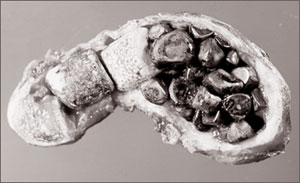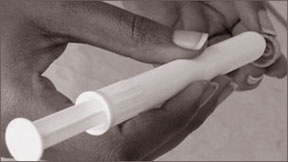|

Stone formation:
Causes and preventive measures
|

Prof. Neville D. Perera
|
In spite of various health precautions some of us still develop
stones. This is often due to misinformation. Certain myths such as
drinking water excessively would prevent formation of stones, instead
could increase the chances.
Fortunately due to advances in medical technology in 95% of the
cases, the stones can be removed without large incisions.
Healthwise spoke to Prof. Neville D. Perera, Consultant Urological
Surgeon, Department of Urology and Renal Transplantation, National
Hospital on the causes, symptoms and treatment for stones.
Stones can develop in many parts of the body. Those that form in the
kidneys,gall bladder and pancreas cause many symptoms and complications.
"Kidney and gallstones are the most common forms of stones. "Kidney
stones are a major problem in many developing countries such as Sri
Lanka," said Prof. Perera.
He explained that the fact most men are susceptible to kidney and
gallstones, has little to do with anatomy. "Except for the fact that
they experience comparatively more pain due to narrower and longer male
urinary tract," explained Prof. Perera. However, he said that men are
susceptible to kidney and gallstones because they work in a dry climate
and are frequently subjected to dehydration, which is a major cause of
stone formation.
Myths
Contrary to popular belief, hard water high in calcium, consumed in
some areas of the country, does not cause stones, explained Prof. Perera.
"It is purified when it passes through the stomach." Prof. Perera
explained that drinking water excessively does not prevent formation of
stones. "In fact recent studies show that if a person drinks more than
four litres of water a day it increases the chances of getting stones."
The recommended total liquid consumption per day of a normal person is
2.5 or three litres on a hot day.
No direct relationship between soft drinks, alcohol and smoking and
stones has been found. Calcium supplements and high calcium milk
products if taken with meals does not lead to stone formation.
"Most patients pass the stone with urine and claim that the stone has
been dissolved", said Prof. Perera. "This is not possible in western
medicine, in fact there is no conclusive scientific evidence that this
can be done."
Causes
Four major causes contribute to the formation of stones explained
Prof. Perera. When a small crystal of stone is formed and does not get
flushed out of the urinary tract it could get bigger. Stones are
composed of phosphate, carbon or calcium oxalate - the most common
element. "These crystals can form due to high calcium or oxalate in
urine caused by large amounts of calcium and oxalates in diet.
Fortunately it is not a common problem in developing countries,"
explained Prof. Perera.
Dehydration due to low water intake could predispose someone to
develop calcium and oxalate crystals. He explained that this could be
clearly observed in the dry regions of the country.
Another mechanism of stone formation is having a block or obstruction
of the urinary tract, which - in children - could result from the
narrowing of ureters due to a birth defect or obstruction to the bladder
by prostrate gland in adults.
|

Gall stones |
Increased secretion of parath hormone by the parathyroid glands,
which leads to high levels of blood calcium, can lead to stones.
Foreign bodies such as bacteria and cells in the urinary tract can
act as a centre point for the formation of a stone. "There is a saying
'all bladder stones are tomb stones of bacteria', said Prof. Perera.
Symptoms
Prof. Perera explained that once a kidney stone forms it tries to
come out through the urinary tract while it is still small. The
signature 'loin to groin pain' - a pain which starts from the loin area
and runs towards the groin - is caused by the 'rolling down' of the
stone through ureter to bladder. Popularly known as 'renal colic' this
pain is only second to pain in child birth. "This is often accompanied
by vomiting, nausea, faintness and sweating."
If the stone is in the kidney or urinary bladder and not moving,
symptoms differ significantly. A dull ache is felt in the loin area or
lower abdomen if the stone is in kidney or bladder and blood mixed in
urine due to scratching of tissue. "If the stone is infected with
bacteria these symptoms can be accompanied by signs of urine infection,
such as a burning sensation while passing urine, fever, chills and
shivering."
When a stone is suspected
The existence of a stone can be confirmed by way of a simple X-ray.
However, Prof. Perera explained that, X-ray detection requires
calcium as a constituent. "Ten percent of stones are not detected by
X-ray because they are made up of uric acid," in which case X-ray has to
be combined with ultrasound scan to show the situation of the kidneys.
If the kidneys show signs of blockage or infection physicians have to
resort to special X-ray methods such as IVU (Intravenous Urogram) or CT
scan. "These tests involve injecting a special radioactive dye and will
provide details of the state of the kidneys."
Treatment
The treatment depends on the size, the location of the stone and
symptoms and complications caused. "Not all stones require active
treatment or removal," said Prof. Perera. Small stones less than five
millimeters in the kidney, which do not cause discomfort to the patient
or damage the kidney can be kept under observation. "All that's needed
is to keep an on the situation with annual ultrasounds and X-rays.
There is a 90% chance that stones less than 5 mm will find their way
out in a matter of weeks." The stones which are 'moving' can also be
kept under observation. Prof. Perera said that there are now new drugs
that relax and expand the urethra (water pipe) and speed up the passage
of these stones. "But these drugs should always be taken under a
physician's advice since they could trigger side effects", warned Prof.
Perera.
If the stone gets bigger and , does not show signs of passing or
causes complications they require removal. Prof. Perera explained that
larger stones which are in the middle of the kidney ureter or bladder
require active treatment.
Prof. Perera explained that less than three decades ago such stones
were removed through open surgeries that involved a large cut in the
abdomen resulting in a life long scar. The cut itself leading to a lot
of complications such as infections, pain, bleeding and bad cosmetic
effects, especially in young people.
Fortunately, due to advances in medical technology within the last
two and half decades most stones can be removed without such large
incisions. ESWL or Extra-corporeal Shock Wave Lithotripsy is a
revolutionary stone crushing method, where a special sound wave is sent
into the body.
Prof. Perera explained that most kidney stones which are less than 2
cm can be crushed into tiny pieces within a half hour session of ESWL
without general anesthesia, as a day procedure or in-and-out procedure.
"No overnight stay is required, only a painkiller is needed to
counteract the pain produced by passage of tiny pieces with urine."
Prof. Perera assured that complications resulting from this procedure
- such as passing blood with urine and infections - are rare and
repetition up to three times is safe. "Because there is a slight chance
that the kidney might get damaged." He said that the procedure is safe
enough to be used on children, but should be avoided on pregnant women,
or as a method of which to crush large or hard stones.
Patients have to undergo 'keyhole surgery' if the stone is too large
or hard to be crushed. Medically known as PCNL (Percutaneous
Nephrolithotripsy) this involves the introduction of a small telescopic
instrument - the size of a pencil - into the kidney through the water
pipe or a direct puncture made in the loin under general anesthesia.
The procedure of introducing the telescopic instrument through the
urinary tract is known as URS (Ureterorenoscopy). Once the stone is
detected through the fibreoptic, it is crushed into powder, allowing it
to get flushed out with urine later on.These methods require special
instruments and trained urological surgeons to perform the surgery.
Ninety-five percent of stones can be removed by these methods without
resorting to large incisions, explained Prof. Perera.
He explained that surgeons resort to open surgery in less than five
percent of the cases, such as in the case of stag horns - very large
stones - or if the kidney is none functioning.
Dangers and complications
"Stones can block the ureters and kidneys," explained Prof. Perera.
Once the kidney is blocked it will stop the filtering of urine. "If
both kidneys are blocked it could lead to kidney failure." Infections
caused by bacteria in the stones could lead to the destruction of the
kidneys. Large stones left unattended for a long period can lead to the
destruction of the bladder.
Prevention
If a patient is regularly subject to stones, he or she may require
special drugs. Prof. Perera explained that this is necessary only in the
case of a birth defect that would require lifelong treatment.
Occasionally, certain diseases in parathyroid glands, which causes an
increased secretion of the parath hormone leads to high blood calcium
levels, resulting in repeated stone formation. "This will require a
parathyroidectomy - removal of effected parathyroid gland(s)."
He explained that if all four glands are removed the patient must
take a calcium supplement.
"Consume an adequate amount of water to prevent dehydration and seek
medical advice as soon as symptoms manifest in order to avoid
complications.
-SP
Gel cuts HIV-infections by half
A vaginal gel has significantly cut the rate of women contracting HIV
from infected partners in an experiment in South Africa, researchers
said.
|

Women in the trial are said to have used the gel largely as
directed |
They said the gel, containing Aids drug tenofovir, cut infection
rates among 889 women by 50% after one year of use, and by 39% after two
and a half years.
If the results are confirmed it would be the first time that a
microbicidal gel has been shown to be effective.
Such a gel could be a defence for women whose partners refuse to wear
condoms.
New ways of curbing the spread of HIV are badly needed, particularly
in sub-Saharan Africa, where nearly 60% of those infected with the virus
are women.
Many women are often forced to take part in unsafe sex, and are
biologically more vulnerable to HIV infection than men, making a gel
they apply an attractive option.Welcoming the results, UN agencies said
they would convene an expert consultation in South Africa next month to
discuss the next steps with the product.
'Just pennies' The results of the three-year study, which was
completed by the Centre for the Aids Programme of Research in South
Africa (Caprisa), are being presented at an international aids
conference in Vienna and were published on Monday by the US magazine
Science.
The gel was found to be both safe and acceptable when used once in
the 12 hours before sex and once in the 12 hours after sex by women aged
18 to 40 years.
Salim Abdool Karim, one of the two leading co-researchers, told
reporters in Vienna that the 889 women involved in the trial, conducted
in the coastal city of Durban and a remote rural village, had largely
used the gel as directed.
They were also given condoms and advice about sexually transmitted
diseases, and tested for HIV once a month.
After 30 months, 98 women became infected with HIV - 38 in the group
that got tenofovir in the gel and 60 in the group that got placebos.
"We showed a 39% lower incidence of HIV in the tenofovir group," Dr
Karim said.
Tenofovir, he added, lowered the risk of infection by 50% at 12
months but then the efficacy declined.
Women who used the gel more consistently were much less likely to be
infected, he said.
He added that he did not know how much each dose would cost but said
the applicators and gel cost "just pennies".
"Boy, have we been doing the happy dance," Dr Karim, from the
University of KwaZulu-Natal in Durban, said.
'Hope for women' "It's the first time we've ever seen any microbicide
give a positive result that you could say was statistically
significant," said Dr Anthony Fauci, director of the National Institute
of Allergy and Infectious Diseases.
The researchers say women who used the gel also showed a significant
reduction in genital herpes, a common sexually transmitted infection,
which itself increases the risk of HIV infection.
The UN's HIV /AIDSagency noted that nearly 20 years of research had
gone into microbicides that can be controlled by a woman, independent of
her partner.
"We are giving hope to women," said Michel Sidibe, executive director
of UNAids.
"For the first time we have seen results for a woman-initiated and
controlled HIV prevention option." A microbicide, he said, would be a
"powerful option for the prevention revolution and help us break the
trajectory of the Aids epidemic".
Dr Margaret Chan, director-general of the World Health Organisation,
welcomed Caprisa's findings.
"We look forward in seeing these results confirmed," she said.
"Once they have been shown to be safe and effective, WHO will work
with countries and partners to accelerate access to these products."
- BBC
[Health News]
Innovations in weight loss surgery
Dr. Brian Quebbemann, surgical director at The N.E.W. Program
weight-loss centre in Newport Beach and TransEnterix, Inc. have teamed
up to develop the Spider surgical tool, which allowed surgeons to
perform bariatric surgery without the typical surgical incision.
The tool enters through a small hole made in the belly button and
cuts down the capacity of the stomach, by up to 80 percent.
Approved by the FDA last year, the Spider has multiple instrument
channels, allowing the surgeon to insert flexible instruments to expand
the abdomen (kind of like an umbrella), minuscule cameras to view the
working environment, and surgical tools to trim the stomach and make
sutures. The Spider is then removed through the same hole.
Also on the horizon, and currently in a multi-centrestudy to gain FDA
approval, is the TOGA System, a less-invasive bariatric procedure that
is performed endoscopically (through the mouth).
A set of flexible devices is inserted through the mouth into the
stomach to staple together sections of the stomach and thus reduce its
overall food capacity.
The TOGA System is a set of flexible stapling devices that is
inserted through the mouth into the stomach. Once the device is in
place, suction is used to gather together tissue from both sides of the
stomach into the device. The collected tissue is then fastened together
with titanium staples.
The procedure creates a small stomach pouch, shaped like a narrow
sleeve, at the top of the stomach. Once the stomach is stapled and the
procedure is complete, the device is removed from the body.
If you are looking for a weight loss plan that does not include any
type of surgery, visit the HealthNews diet pages and test out our
Individual Diet Selection tool, which can help find the right diet for
you lifestyle.
- Healthnews
|

